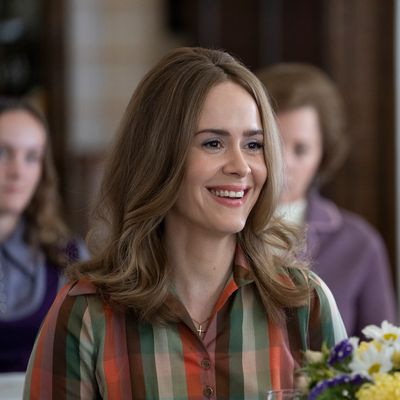
Mrs. America, FX’s limited series on the fight over the Equal Rights Amendment, is full of famous women playing other famous women, from Rose Byrne as Gloria Steinem to Margo Martindale as congresswoman Bella Abzug. But one of its most arresting stars, Sarah Paulson, is no famous figure in the show. Instead, she plays Alice Macray, a composite character and sidekick to the anti-feminist movement’s leader, Phyllis Schlafly, played by Cate Blanchett.
Paulson’s character is a much more demure and nervous anti-feminist than Schlafly, seemingly only in the fight to “protect” her status as a Stepford-like homemaker. But by the series’ final episodes, it’s clear that Alice is not Phyllis, and that she has recognized some of the flaws of her own movement. (The show’s writer, Dahvi Waller, told the Cut that Alice was actually based on several figures in Phyllis’s life, including a neighbor who had an awakening, joined NOW, and opened a pro-ERA headquarters across from Phyllis’s husband’s office.) Paulson spoke with the Cut by phone to discuss how she prepared for the unique role, what it’s like to be a queer icon playing a conservative woman, and making fun of the Cate Blanchett on set.
What was it that initially attracted you to Mrs. America?
Well, Cate Blanchett and I are lucky enough to share an agent who is a wonderful woman and a very smart, savvy lady to boot. She called me on the phone and said, “This hasn’t been announced yet, but Cate’s going to do this project, and there are several parts you could play. Many of them have not been fleshed out, and they’ve not written beyond episode two.” I had to say to our agent, “You kind of had me at ‘Cate’s doing this,’” which I think is how most people feel. This is my third time in the playpen with Cate in the acting department, which is really kind of a badge of honor.
How did you prepare to play Alice, who was actually based on numerous women from the anti-feminist and feminist movements?
There was a kind of jealousy I felt walking into the makeup trailer, and everybody’s real-life counterpart was plastered up on the trailer walls. I personally always love having a real-life template. When you’re playing a real person, I think there’s enormous freedom in it. Without having a blueprint, you sometimes are not sure how far to push something or how much to restrain yourself.
And of course, who wants to be called “Sarah Paulson as the composite character”? That’s not really super sexy. You have Rose Byrne as Gloria Steinem! Tracey Ullman [as Betty Friedan]! You have this list of extraordinary performers playing these extraordinarily famous women! And Sarah Paulson as “Alice Macray, composite character.” [Laughing.]
There was definitely a part of me that was jealous, and at the same time very protective of Alice and feeling like, “No. Don’t call her a composite character. I’ve got to turn her into a full-fledged person or I won’t have done this right.”
I know when I was watching the show, I secretly wanted Alice to have a sort of “feminist comeuppance,” as much as that might not be realistic. I really wanted her to switch to the other side. How generous did you want to be to the character?
Well, that’s the thing: It would be very easy to have this episode for Alice that’s like “Alice Through the Looking Glass.” She drops down a rabbit hole and goes into this entire other universe and comes out the other side a changed person. But I felt really resistant to the idea that she would just shed everything about her that had shaped her life up until that moment. Because I don’t think that’s realistic, and I don’t think it’s fair, and then it ends up making it seem like, “Oh, her life before was not a real, full life.”
That was something important for me and to Dahvi [Waller, the show’s creator] that we kept saying, “It’s not like Alice becomes a feminist.” She’s just incapable of holding her new worldview at bay. She’s digested it too much. It was too powerful. It’s like swallowing the moon and you can’t not let that light out.
I hope you don’t mind me saying this, but you’re kind of a total queer-lady icon. In the “Houston” episode, which takes place at the National Women’s Conference, Alice stands up against a resolution to protect queer women’s rights. Watching that honestly hurt a little. Did you have a difficult time portraying someone with these views?
The thing I kept hooking into with Alice that made it possible for me to play her — because she does have so many beliefs that I just don’t line up with — the thing that I could tap into that I think she always had was compassion and an essential goodness. Once her eyes were opened and once … she goes into the gay and lesbian wing of this Houston convention and she sees the heartbreak right in front of her, there’s no way for her to not hold that and be moved by it and to just essentially recognize that people are people. So it wasn’t as hard to muscle my way into that. I knew that ultimately once she saw it, she couldn’t unsee it. And then she would never be the same.
What was it like working with Cate again, and how was this different from past jobs together?
I had so much sympathy for her reality while doing this. Cate had never done a scripted television project before with nine hours, which is a lot of volume and a lot of story … She was in every frame and the rest of us, you know, we were coming and going. We would all hang out, a lot of us — [Elizabeth] Banks, and Margo, and Tracey [Ullman], and Rose, and Ari [Graynor], Uzo [Aduba], Jeanne Tripplehorn — we all knew each other from New York and L.A. We could go to dinner, and have a cocktail! And we’re not working in the morning! And poor Cate … poor Cate just never had that day. So getting her to be able to feel free enough to come and hang out with us delinquents was hard, because she had such a responsibility and didn’t get to have as much of the “camp fun” that we got to have. I almost felt like a mother hen [in a baby voice]: “Oh my little — I know just what you’re experiencing, and I’m so sorry you’re not able to have several martinis and hang out with all of us.”
The first time I worked with her on Carol, she’d won the Oscar [for Blue Jasmine] four days before we started working, and I had to drive her in this Packard. It was just a tank, a giant car. I was like, “You want me to take newly minted Academy Award winner Cate Blanchett in the car and you want me to not mow down any crew members and not kill her?” It was a very nerve-racking experience. But by the time this came around — it was the second time I was playing her closest friend and the third time we worked together, so I obviously have so much respect for her, and she’s such a wonderful person and extraordinarily present scene partner. Like I said, I really wear it very proudly: three-time Blanchett scene partner. The thing people don’t really know about her is that she’s really the most fun … She’s “Dame Blanchett” and she’s “Cate the Great,” and all that’s really true, but man the number of takes we blew laughing? I can’t even tell you. There’s no one funnier.
Is there a scene that comes to mind? I was wondering how hard it was to film the scene where Alice has a fever dream of Phyllis choking her out.
That was one of those moments where I was like, “Ummm, uhh, Cate, your hand is salty.” Like her hand was all over my mouth [laughing]. And she was like, “Oh God, I’ve got your saliva on my hand.” And I was like, “Oyyy, get outta here lady.”
But that wasn’t even one of the moments where we just laughed. You know, Cate’s got these teeth in. Those aren’t her teeth. I would make fun of her a lot, and she’s got a great sense of humor for being teased and so I’d be like, [in a silly, dorky voice] “I’m Phyllis Schllllafffly! Schlllafffly!” with my teeth. She’d be like, “Oh God, things were going so well before you got here, and now I have to worry that you’re going to make fun of me every five seconds.” And I was like, “That’s what I’m here for.”
This conversation has been edited and condensed for clarity.


